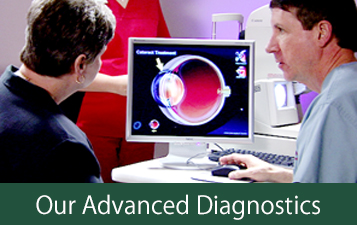Wallace Eye Associates: Advancing The Art of Eye Care
The good news is that cataract surgery is one of the safest, most successful and commonly performed surgeries in the United States. As with any surgical procedure, there are inherent risks and complications that can occur. But 9 out of 10 people regain very good vision somewhere between 20/20 and 20/40 according to Prevent Blindness America (PBA). The even better news is that with FDA approved advanced lens technology patients have options that reduce or eliminate any need for glasses after cataract surgery.
What is a Cataract?
A cataract is the clouding of the eye’s naturally clear lens. In addition to the natural aging factor, there are other factors that can cause cataracts. These include exposure to ultraviolet light, trauma, diabetes and even lifestyle factors such as diet, alcohol consumption and smoking could lead to the development of a cataract.
Common Symptoms Of A Cataract:
As cataracts begin to develop, many things in life will begin to look less vivid. Colors will not be as bright. Objects become cloudy and blurry. Driving at night will be more and more difficult and you will be begin to have issues with glare.
Fortunately, modern-day cataract removal and lens implantation is one of the safest, most common – AND MOST SUCCESSFUL – surgical procedures performed today. In the past, cataract patients were forced to wear reading glasses and/or bifocals after their procedure. Today, our new lens implants are designed to reduce – and in some cases – eliminate your dependence on corrective eyewear after cataract surgery.
Cataract Surgery
Over fifty percent of people over the age of 60, and quite a few younger than that, suffer from cataracts. Currently there is no medical treatment to reverse or prevent the development of cataracts. Once they form, the only way to see clearly again is to have them removed from within the eye.
In your parents’ or grandparents’ day, cataract surgery was considered risky, required a lengthy hospital stay and was usually postponed for as long as possible. Today, cataract surgery is performed on an outpatient basis and takes only a few minutes. It is now one of the most common and successful medical procedures performed. In fact, following cataract surgery, many patients experience vision that is actually better than what they had before they developed cataracts. See what cataract patients have to say about their cataract surgery.
Cataract surgery is for those who:
- believe that their quality of life has been impaired by poor vision
- have been diagnosed with cataracts
- have no health issues affecting their eyes
What to expect on surgery day:
You will arrive at The Wallace Laser and Surgery Center about an hour prior to your procedure. Once you have been checked in you may be offered a sedative to help you relax. You will then be prepared for surgery. The area around your eyes will be cleaned and a sterile drape may be applied around your eye.
Making You comfortable During Surgery
You will remain awake and comfortable during your procedure. Eye drops or a local anesthetic will be used to numb your eye. When your eye is completely numb, an eyelid holder will be placed between your eyelids to keep you from blinking during the procedure. A very small incision will be made and a tiny ultrasonic probe will be used to break up the cataract into microscopic particles using high-energy sound waves. This is called phacoemulsification.
Removing your Cataract
The cataract particles will be gently suctioned away. Then, a folded intra-ocular lens (IOL) will be inserted through the micro-incision, then unfolded and locked into permanent position. The small incision is “self-sealing” and usually requires no stitches. It remains tightly closed by the natural outward pressure within the eye. This type of incision heals fast and provides a much more comfortable recuperation.
You may also choose to make an appointment or request additional information to learn more about this exciting procedure.



